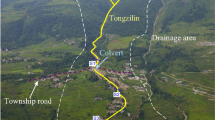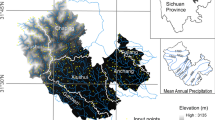Abstract
Debris flows are abrupt geological hazards frequently resulting in destructive disasters in mountain areas. Thus, analysis of the acceptable risk of debris-flow disasters should be attentively considered, whereas the crucial problem of the acceptable disaster risk is how to know what the risk levels of debris-flow disasters are acceptable for the public. Thence, the questionnaire investigation of the acceptable risk preferences for different populations in various regions can be such a solution. The acceptable disaster risks are not only taking into account people's acceptance, but also related to government's disaster-reduction strategy and also referred to expert’s professional evaluation. Therefore, the establishment of guidelines and criterions for the acceptable risks of debris-flow disasters need all participations from multiple populations and different regions. In this survey, three-category populations including ordinary people, experts/scholars and administrators across China joined the questionnaire investigation. Five indicators (disaster-affected toll, death toll, death rate, personal direct economic loss, and total direct economic loss) were used to describe the acceptable risks of debris-flow disasters. Incorporated with frequency analysis, this work has explained the demographic characteristics for the acceptable risk preferences. The results indicate that ordinary people have relatively low acceptable risks, experts/scholars have slightly high acceptable risks and administrators have acceptable risks between both of them. Educational level, occupation, and income were the dominatingly demographic factors for the interpretations of the acceptable risk preferences.







Similar content being viewed by others
References
Amendola A, Linnerooth-Bayer J, Okada N, Shi P (2008) Towards integrated disaster risk management: case studies and trends from Asia. Nat Hazards 44:163–168
Arrow KJ (2007) Risk perception in psychology and economics. Econ Inq 10:1–9
Azarafza M, Ghazifard A, Akgün H, Asghari-Kaljahi E (2018) Landslide susceptibility assessment of South Pars Special Zone, southwest Iran. Environ Earth Sci 77:805
Barnett J, Breakwell GM (2001) Risk perception and experience: hazard personality profiles and individual differences. Risk Anal 21:171–177
Binswanger HP (1980) Attitude towards risk: Experimental measurement in rural India. Am J Agr Econ 62:395–407
Bucci DD, Savadori L (2018) Defining the acceptable level of risk for civil protection purposes: A behavioral perspective on the decision process. Nat Hazards 90:293–324
Castellanos Abella EA, Van Westen CJ (2007) Qualitative landslide susceptibility assessment by multicriteria analysis: a case study from San Antonio del Sur, Guantanamo. Cuba Geomorphol 94:453–466
Charness G, Eckel C, Gneezy U, Kajackaite A (2018) Complexity in risk elicitation may affect the conclusions: A demonstration using gender differences. J Risk Uncertain 56:1–17
Dillon JL, Scandizzo PL (1978) Risk attitude of subsistence farmers in northeast Brazil: a sampling approach. Am J Agr Econ 60:425–435
Djalante R, Holley C, Thomalla F, Carnegie M (2013) Pathways for adaptive and integrated disaster resilience. Nat Hazards 69:2105–2135
Duan J, Liu Y, He Q (2012) The effects of decision makers’ roles and related variables on risk preferences. Acta Psychol Sinica 44:369–376
Eiser JR, Bostrom A, Burton I, Johnston DM, McClure J, Paton D, van der Pligt J, White MP (2012) Risk interpretation and action: A conceptual framework for responses to natural hazards. International Journal of Disaster Risk Reduction 1:5–16
Fan JC, Huang HY, Liu CH, Yang CH, Guo JJ, Chang CF, Chang YC (2015) Effects of landslide and other physiographic factors on the occurrence probability of debris flows in central Taiwan. Environ Earth Sci 74:1785–1801
Fischhoff B, Slovic P, Lichtenstein S (1978) How safe is safe enough? A psychometric study of attitudes towards technological risks and benefits. Policy Sci 9:127–152
Gotham KF, Campanella R, Lauve-Moon K, Powers B (2018) Hazard experience, geophysical vulnerability and flood risk perceptions in a postdisaster city, the case of New Orleans. Risk Anal 38:345–356
Hillson D, Murray-Webster R (2007) Understanding and managing risk attitude, 2nd edn. Gower Publishing Ltd., Aldershot, Hampshire, United Kingdom
Holt C, Laury S (2002) Risk aversion and incentive effects. American Economic Review 92:1644–1655
Iqbal MA, Ping Q, Abid M, Kazmia SMM, Rizwana M (2016) Assessing risk perceptions and attitude among cotton farmers: a case of Punjab province, Pakistan. Int J Disaster Risk Reduc 16:68–74
Jia Y, Liu, X, Shang Z (2012) Questionnaire design of acceptable risk of debris flow disaster. In: Huang C, Zhai G (ed) Proceedings of the 5th Annual Meeting of Risk Analysis Council of China Association for Disaster Prevention. Atlantis Press, Paris, France, pp 397–402
Jiang Y, Luo Y, Xu X (2019) Flood insurance in China: Recommendations based on a comparative analysis of flood insurance in developed countries. Environ Earth Sci 78:93
Klimeš J, Rosario AM, Vargas R, Raška P, Vicuña L, Jurt C (2019) Community participation in landslide risk reduction: a case history from Central Andes, Peru. Landslides 16:1763–1777
Liu X (1996) Size of a debris flow deposition: Model experiment approach. Environ Geol 28:70–77
Liu X, Miao C (2018) Acceptability of debris-flow disasters and influential factors in a hazard prone area of northwestern China. Int J Disaster Risk Reduc 31:58–67
Liu X, Miao C (2019) Acceptability of debris-flow disasters: Comparison of two case studies in China. Int J Disaster Risk Reduc 34:45–54
Miao C, Liu X (2020) Characterization of acceptable risk for debris flows in China: Comparison in debris-flow prone areas and nonprone areas. Int J Disaster Risk Reduc 42:101405
Osei EK, Amoh GEA, Schandorf C (1997) Risk ranking by perception. Health Phys 72:195–203
Shang Z (2017) Current situation and progress of natural disaster risk communication research. Safety Environ Eng 24:30–36
Sjöberg L (2002) The allegedly simple structure of experts’ risk perception: An urban legend in risk research. Sci Technol Human Values 27:443–459
Slovic P (1987) Perception of risk. Science 236:280–285
Slovic P (1999) Trust, emotion, sex, politics and science: Surveying the risk-assessment battlefield. Risk Anal 19:689–701
Starr C (1969) Social benefit versus technological risk. Science 165:1232–1238
Ullah R, Shivakoti GP, Kamran A, Zulfiqar F (2016) Farmers versus nature: managing disaster risks at farm level. Nat Hazards 82:1931–1945
UNISDR (2009) Terminology on disaster risk reduction. The United Nations International Strategy for Disaster Reduction, Geneva, Switzerland. http://www.unisdr.org/files/7817_UNISDRTerminologyEnglish.pdf
UNISDR (2015) Sendai framework for disaster risk reduction 2015–2030. The United Nations office for disaster risk reduction, Geneva
Wachinger G, Renn O, Begg C, Kuhlicke C (2013) The risk perception paradox–Implications for governance and communication of natural hazards. Risk Anal 33:1049–1065
Wang J, Hu Z (2014) The expert-lay differences in risk perception. Stud Dialect Nat 30:49–53
Winter MG, Bromhead EN (2012) Landslide risk: Some issues that determine societal acceptance. Nat Hazards 62:169–187
Wray LD, Stone ER (2005) The role of self-esteem and anxiety in decision making for self versus others in relationships. J Behav Dec Making 18:125–144
Ye T, Wang M (2013) Exploring risk attitude by a comparative experimental approach and its implication to disaster insurance practice in China. J Risk Res 16:861–878
Zeng W, Huang B (2005) Analysis on the reliability and validity of questionnaire. Stat Info Forum 20:11–15
Zhou H (2017) Hot-topics and prospects of global platform for disaster risk reduction: based on 2017 global platform for disaster risk reduction in Cancun, Mexico. Adv Earth Sci 32:688–695
Acknowledgements
The study was financially supported by the National Natural Science Foundation of China (Grant Nos. 41171407, 41971006). Many thanks are extended to Zhihai Shang, Yaoyao Jia, Dalin Zhang, Bo Tang, Qingqin Huang and Hongting Zhao for their participations in the questionnaire investigations. We appreciate the editor’s and an anonymous reviewer’s valuable comments which greatly improved the manuscript quality.
Author information
Authors and Affiliations
Corresponding author
Ethics declarations
Conflict of interest
The authors declare no conflicts of interest.
Additional information
Publisher's Note
Springer Nature remains neutral with regard to jurisdictional claims in published maps and institutional affiliations.
Rights and permissions
About this article
Cite this article
Liu, X., Miao, C. Analysis of the acceptable risk preferences of debris-flow disasters for three-category populations and their demographic characteristics in China. Nat Hazards 107, 971–990 (2021). https://doi.org/10.1007/s11069-021-04618-8
Received:
Accepted:
Published:
Issue date:
DOI: https://doi.org/10.1007/s11069-021-04618-8




